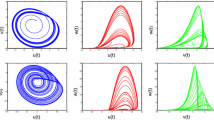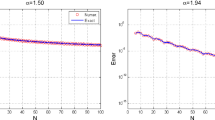Abstract
In this paper, we consider two accurate iterative methods for solving fractional differential equations with power law and Mittag–Leffler kernel. We focused our attention on the stage-structured prey–predator model and several chaotic attractors of type Newton–Leipnik, Rabinovich–Fabrikant, Dadras, Aizawa, Thomas’ and 4 wings. The first algorithm is based on the trapezoidal product-integration rule, and the second one is based on Lagrange interpolations. The results obtained show that both numerical methods are very efficient and provide precise and outstanding results to determine approximate numerical solutions of fractional differential equations with non-local singular kernels.






























Similar content being viewed by others
References
Caponetto R, Dongola G, Fortuna L, Petrás I (2010) Fractional order systems modeling and control applications. World Sci Ser Nonlinear Sci Ser A 77:177
Goufo EFD, Kumar S, Mugisha SB (2020) Similarities in a fifth-order evolution equation with and with no singular kernel. Chaos, Solitons Fractals 130:1–10
Ghanbari B, Kumar S, Kumar R (2020) A study of behaviour for immune and tumor cells in immunogenetic tumour model with non-singular fractional derivative. Chaos, Solitons Fractals 133:1–11
Kumar S, Nisar KS, Kumar R, Cattani C, Samet B (2020) A new Rabotnov fractional-exponential function-based fractional derivative for diffusion equation under external force. Math Methods Appl Sci 43(7):4460–4471
Kumar S, Kumar A, Abbas S, Al Qurashi M, Baleanu D (2020) A modified analytical approach with existence and uniqueness for fractional Cauchy reaction-diffusion equations. Adv Differ Equ 2020(1):1–18
Kumar S, Kumar R, Agarwal RP, Samet B (2020) A study of fractional Lotka-Volterra population model using Haar wavelet and Adams-Bashforth-Moulton methods. Math Methods Appl Sci 43(8):5564–5578
Alshabanat A, Jleli M, Kumar S, Samet B (2020) Generalization of Caputo-Fabrizio fractional derivative and applications to electrical circuits. Front Phys 8:1–13
Samko SG, Kilbas AA, Marichev OI (1993) Fractional integrals and derivatives: theory and applications. Gordon and Breach, Yverdon
Caputo M, Fabrizio M (2015) A new definition of fractional derivative without singular Kernel. Progr Fract Differ Appl 1:73–85
Atangana A, Baleanu D (2016) New fractional derivatives with nonlocal and non-singular kernel: theory and application to heat transfer model. Therm Sci 20:1–16
Mohyud-Din ST, Nawaz T, Azhar E, Akbar MA (2017) Fractional sub-equation method to space-time fractional Calogero-Degasperis and potential Kadomtsev-Petviashvili equations. J Taibah Univ Sci 11(2):258–263
Jafari H, Ghorbani M, Ghasempour S (2013) A note on exact solutions for nonlinear integral equations by a modified homotopy perturbation method. New Trends Math Sci 1(2):22–26
Sugiura H, Hasegawa T (2009) Quadrature rule for Abel’s equations: uniformly approximating fractional derivatives uniformly approximating fractional derivatives. J Comput Appl Math 223:459–468
Rosenfeld JA, Dixon WE (2017) Approximating the Caputo fractional derivative through the Mittag-Leffler reproducing kernel Hilbert space and the kernelized Adams-Bashforth-Moulton method. SIAM J Numer Anal 55(3):1201–1217
Diethelm K, Ford NJ, Freed AD (2002) A predictor-corrector approach for the numerical solution of fractional differential equations. Nonlinear Dyn 29(1–4):3–22
Diethelm K, Ford NJ, Freed AD (2004) Detailed error analysis for a fractional Adams method. Numer Algorithms 36(1):31–52
Daftardar-Gejji V, Sukale Y, Bhalekar S (2014) A new predictor-corrector method for fractional differential equations. Appl Math Comput 244:158–182
Asl MS, Javidi M (2017) An improved PC scheme for nonlinear fractional differential equations: error and stability analysis. J Comput Appl Math 324:101–117
Gnitchogna R, Atangana A (2017) New two step laplace Adam-Bashforth method for integer a noninteger order partial differential equations. Numer Methods Partial Differ Equ 34(5):1739–1758
Toufik M, Atangana A (2017) New numerical approximation of fractional derivative with non-local and non-singular kernel: application to chaotic models. Eur Phys J Plus 132(10):1–16
Li C, Yi Q, Chen A (2016) Finite difference methods with non-uniform meshes for nonlinear fractional differential equations. J Comput Phys 316:614–631
Zhao L, Deng W (2014) Jacobian-predictor-corrector approach for fractional differential equations. Adv Comput Math 40(1):137–165
Mishra J (2018) Fractional hyper-chaotic model with no equilibrium. Chaos Solitons Fractals 116:43–53
Boubellouta A, Boulkroune A (2019) Intelligent fractional-order control-based projective synchronization for chaotic optical systems. Soft Comput 23(14):5367–5384
Deshpande A, Daftardar-Gejji V (2019) Chaotic dynamics of fractional Vallis system for El-Nino. Fract Calc Appl Anal 22(3):825–842
Abdeljawad T, Baleanu D (2017) Integration by parts and its applications of a new nonlocal fractional derivative with Mittag-Leffler nonsingular kernel. J Nonlinear Sci Appl 10:1098–1107
Arora C, Kumar V, Kant S (2017) Dynamics of a high-dimensional stage-structured prey-predator model. Int J Appl Comput Math 3(1):427–445
Ghanbari B, Kumar D (2019) Numerical solution of predator-prey model with Beddington-DeAngelis functional response and fractional derivatives with Mittag-Leffler kernel. Chaos 29(6):1–12
Diethelm K (1997) An algorithm for the numerical solution of differential equations of fractional order. Electron Trans Numer Anal 5(1):1–6
Diethelm K, Ford NJ, Freed AD (2002) A predictor-corrector approach for the numerical solution of fractional differential equations. Nonlinear Dyn 29(1–4):3–22
Diethelm K, Ford NJ (2002) Analysis of fractional differential equations. J Math Anal Appl 265(2):229–248
Diethelm K, Ford NJ, Freed AD (2004) Detailed error analysis for a fractional Adams method. Numer algorithms 36(1):31–52
Diethelm K, Ford NJ, Freed AD, Luchko Y (2005) Algorithms for the fractional calculus: a selection of numerical methods. Comput Methods Appl Mech Eng 194(6–8):743–773
Diethelm K, Ford NJ (2004) Multi-order fractional differential equations and their numerical solution. Appl Math Comput 154(3):621–640
Hairer E, Lubich C, Schlichte M (1985) Fast numerical solution of nonlinear Volterra convolution equations. SIAM J Sci Stat Comput 6(3):532–541
Diethelm K, Ford NJ, Freed AD (2004) Detailed error analysis for a fractional Adams method. Numer Algorithms 36(1):31–52
Popolizio M (2018) Numerical solution of multiterm fractional differential equations using the matrix Mittag-Leffler functions. Mathematics 6(1):1–7
Garrappa R (2018) Numerical solution of fractional differential equations: a survey and a software tutorial. Mathematics 6(2):1–16
Solís-Pérez JE, Gómez-Aguilar JF, Atangana A (2018) Novel numerical method for solving variable-order fractional differential equations with power, exponential and Mittag-Leffler laws. Chaos Solitons Fractals 116:114–120
Samko SG (1995) Fractional integration and differentiation of variable order. Anal Math 21(3):213–236
Samko S (2013) Fractional integration and differentiation of variable order: an overview. Nonlinear Dyn 71(4):653–662
Malesza W, Macias M, Sierociuk D (2019) Analytical solution of fractional variable order differential equations. J Comput Appl Math 348:214–236
Sun H, Chang A, Zhang Y, Chen W (2019) A review on variable-order fractional differential equations: mathematical foundations, physical models, numerical methods and applications. Fract Calc Appl Anal 22(1):27–59
Garrappa R, Popolizio M (2011) On accurate product integration rules for linear fractional differential equations. J Comput Appl Math 235(5):1085–1097
Sheu LJ, Chen HK, Chen JH, Tam LM, Chen WC, Lin KT, Kang Y (2008) Chaos in the Newton-Leipnik system with fractional order. Chaos Solitons Fractals 36(1):98–103
Luo X, Small M, Danca MF, Chen G (2007) On a dynamical system with multiple chaotic attractors. Int J Bifurc Chaos 17(09):3235–3251
Dadras S, Momeni HR, Qi G (2010) Analysis of a new 3D smooth autonomous system with different wing chaotic attractors and transient chaos. Nonlinear Dyn 62(1–2):391–405
Aizawa Y (1982) Global Aspects of the Dissipative Dynamical Systems I: Statistical Identification and Fractal Properties of the Lorenz Chaos. Progress Theoret Phys 68(1):64–84
Thomas R (1999) Deterministic chaos seen in terms of feedback circuits: Analysis, synthesis, labyrinth chaos. Int J Bifurc Chaos 9(10):1889–1905
En-Zeng D, Zai-Ping C, Zeng-Qiang C, Zhu-Zhi Y (2009) A novel four-wing chaotic attractor generated from a three-dimensional quadratic autonomous system. Chin Phys B 18(7):1–16
Acknowledgements
José Francisco Gómez Aguilar acknowledges the support provided by CONACyT: cátedras CONACyT para jóvenes investigadores 2014 and SNI-CONACyT.
Author information
Authors and Affiliations
Corresponding author
Ethics declarations
Conflicts of interest
The authors declare no conflict of interest.
Additional information
Publisher's Note
Springer Nature remains neutral with regard to jurisdictional claims in published maps and institutional affiliations.
Rights and permissions
About this article
Cite this article
Ghanbari, B., Gómez-Aguilar, J.F. Two efficient numerical schemes for simulating dynamical systems and capturing chaotic behaviors with Mittag–Leffler memory. Engineering with Computers 38, 2139–2167 (2022). https://doi.org/10.1007/s00366-020-01170-0
Received:
Accepted:
Published:
Issue Date:
DOI: https://doi.org/10.1007/s00366-020-01170-0




